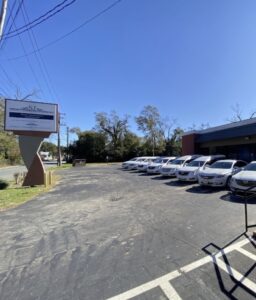
When most people think about a first responder, they consider the following: police officers, EMTs, EMS, and any nurse or doctor around the premises. In the ’60s, during segregation, Black communities relied on funeral homes, midwives, and any trained caretaker to nurse them back to health. These accommodations were due to Black communities being ostracized from proper health care because of segregation.
According to AP News, funeral homes served as a gathering place for Black people. Funeral homes were the first to arrive on the scene for Black people in need. They served as transportation for civil rights leaders and held home-going celebrations for Black people who had passed.
Strong & Jones Funeral Home Inc., located in Tallahassee, Fl., has been a part of this history and created access to immediate and ongoing help during segregation.
“In the 60’s era, the funeral hearse was used as an ambulance and for the burial portion,” Thomas J. Griffin Jr said. “We used to even have the hearses at the FAMU football games just like the ambulances are now.”
He is a part of generations of morticians and funeral owners at Strong & Jones Funeral Home Inc. Their family funeral home served as transportation and burial services and provided prints and brochures for local activists and protests. “It wasn’t until later that hospitals started to have their ambulances and provided transportation for Black communities,” said Griffin. He then shared how FAMU’s hospital was known for birthing many Black children transported by their business.
A child born at FAMU’s hospital, alive and well today, is now a Professor at the university, Kenneth Jones.
“FAMU’s hospital was about access because you had nowhere to go,” Jones said. “You were either born there or at home with a midwife.”
With Jones’s statement in mind, midwives have been around for centuries.
According to NPR News, Mary Stepp Burnette Hayden, a midwife and herbal doctor born into slavery and freed by the age of seven, practiced as a midwife until the age of 90.
“Back when Granny started, there were no hospitals for Black people to go to, and poor people had no money to pay for professional medical care,” Mary Othella Burnette, Hayden’s granddaughter said. “So if you had a disease that could not be treated by a midwife, you died at home.”
Midwife student, physical trainer, and Black woman Nadia Hassani shared her experience.
“Black women in America today have been silenced by society because of the ‘strong’ face they have worn; as a result, thousands of mothers have lost their lives in the child-birthing process due to a lack of medical attentiveness,” she said. “Doulas and midwives are a fundamental key to advocating and supporting families through the process of giving birth, and I feel honored to be a part of this growing sector in the medical and counseling workforce.”
People like Hassani have found the importance of Black people filling the medical world’s spaces. She has provided access and gentle care for people of color, just as many have done before her. Access to better health and proper first responders with equipment came with time. As we advance, access to better health opportunities is expected to improve with innovations and new studies.